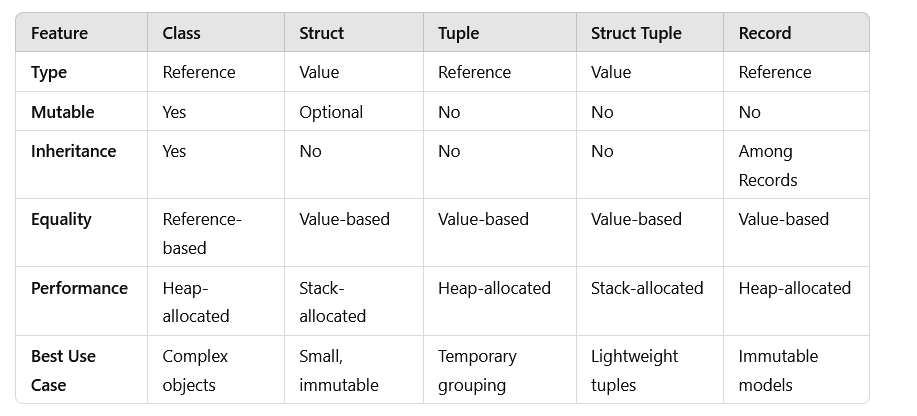Class vs Struct vs Tuple vs Struct Tuple vs Record: A Comprehensive Comparison
Choosing the Right Data Structure for Your C# Application
C# provides a variety of ways to organize and manage data, such as classes, structs, tuples, struct tuples, and records. Each has unique features and use cases. In this blog, we’ll explore their differences, when to use them, and how to choose the best option for your scenario.
1. Class
A class is a reference type in C#. It is ideal for complex data models and scenarios where the object’s identity and behavior are important.
Features:
Reference type: Stored on the heap, and variables hold references to the memory location.
Mutable: Allows changes to properties after creation.
Supports inheritance: Can derive from other classes, making it suitable for OOP.
Garbage collected: Memory is managed by the runtime.
Use Case:
Complex objects with methods, inheritance, and a need for identity.
Example: A
Personclass.
public class Person
{
public string Name { get; set; }
public int Age { get; set; }
public void CelebrateBirthday()
{
Age++;
}
}
Advantages:
Supports inheritance and polymorphism.
Ideal for objects requiring a lifecycle or state.
👋 Become 1% better at .NET Full Stack development every day.
👆 https://dotnet-fullstack-dev.blogspot.com/
♻ Restack it Vibe matches, help others to get it
Disadvantages:
Allocated on the heap, leading to potential performance overhead.
Not suitable for high-performance or memory-sensitive tasks.
2. Struct
A struct is a value type in C#. It is lightweight and suitable for small, immutable data models.
Features:
Value type: Stored on the stack (or inline with the containing object).
Immutable by default: Modifying a struct creates a new copy.
No inheritance: Cannot derive from another struct or class.
Use Case:
Small, immutable objects where performance is critical.
Example: A
Pointstruct.
public struct Point
{
public int X { get; }
public int Y { get; }
public Point(int x, int y)
{
X = x;
Y = y;
}
}
Advantages:
Lightweight and efficient for small objects.
Eliminates heap allocation, reducing GC pressure.
Disadvantages:
No inheritance or polymorphism.
Copying structs can be inefficient if the struct is large.
3. Tuple
A tuple is a lightweight, immutable data structure for grouping related data.
Features:
Immutable: Values cannot be changed after creation.
Reference type: Stored on the heap.
Supports deconstruction: Easily assign tuple elements to individual variables.
Use Case:
Temporary data structures for returning multiple values from methods.
Example: Returning coordinates from a method.
public (int X, int Y) GetCoordinates()
{
return (10, 20);
}
Advantages:
Quick and easy for grouping related values without defining a new type.
Readable syntax for returning multiple values.
Disadvantages:
Less meaningful property names can reduce readability.
Reference type, so not ideal for high-performance scenarios.
4. Struct Tuple
A struct tuple (introduced in .NET Core 2.0) is a value type version of a tuple, providing similar functionality but with better performance in certain scenarios.
Features:
Immutable: Like tuples, struct tuples are immutable.
Value type: Stored on the stack, not the heap.
Improved performance: Reduces GC overhead compared to regular tuples.
Use Case:
Performance-critical scenarios where tuple-like behavior is needed.
Example: Representing lightweight, immutable pairs.
using System.ValueTuple;
public (int X, int Y) GetLightweightCoordinates()
{
return (10, 20);
}
Advantages:
Combines the simplicity of tuples with the efficiency of value types.
No heap allocations, making it ideal for high-performance applications.
Disadvantages:
Still lacks meaningful property names unless explicitly defined.
5. Record
A record is a reference type introduced in C# 9. It is designed for immutable data models with value-based equality.
Features:
Reference type: Stored on the heap, like a class.
Immutable by default: Properties cannot be modified after creation.
Value-based equality: Two records with the same values are considered equal.
Deconstruction: Supports easy deconstruction into variables.
Use Case:
Data transfer objects (DTOs), configuration settings, or data models.
Example: A
Userrecord.
public record User(string Name, int Age);
Advantages:
Simplifies immutable data modeling with value equality.
Built-in
ToString,Equals, andGetHashCodeimplementations.Cleaner syntax for defining immutable objects.
Disadvantages:
Slightly less performant than structs due to heap allocation.
Cannot inherit from other classes (but supports inheritance among records).
Comparison Table
How to Choose?
Use a Class when:
The object requires behavior (methods) and identity.
Inheritance or polymorphism is needed.
Use a Struct when:
You need a lightweight, value-type object.
The object is small, immutable, and frequently allocated.
Use a Tuple when:
You need to return multiple values without defining a new type.
Performance is not critical.
Use a Struct Tuple when:
You need tuple-like functionality in performance-critical scenarios.
Use a Record when:
Modeling immutable data objects with value-based equality.
Creating clean and readable DTOs or data models.
Conclusion
C# offers versatile options for organizing data, each tailored for specific use cases. Choosing the right structure—whether it’s a class, struct, tuple, struct tuple, or record—depends on the requirements of your application in terms of mutability, performance, and complexity. Understanding these differences ensures you write code that’s efficient, maintainable, and easy to understand.
Have you found a favorite among these options? Share your experience or any challenges you've faced in choosing the right one!



